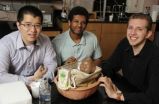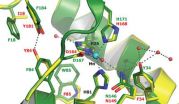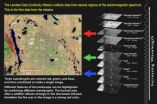Researchers from the Ragon Institute of MGH, MIT and Harvard University have now developed a new approach to vaccine design that may allow them to cut off those evolutionary escape routes. The researchers have developed and experimentally validated a computational method that can analyze viral protein sequences to determine how well different viral strains can reproduce in the body. That knowledge gives researchers an unprecedented guide for identifying viral vulnerabilities that could be exploited to design successful vaccine targets.
The team, led by Arup Chakraborty, the Robert T. Haslam Professor of Chemical Engineering, Chemistry, Physics and Biological Engineering at MIT, has designed protein fragments (peptides) that would target these weaknesses. Ragon Institute researchers are now developing ways to deliver the peptides so they can be tested in animals.
"We think that, if it continues to be validated against laboratory and clinical data, this method could be quite useful for rational design of the active component of a vaccine for diverse viruses. Furthermore, if delivered properly, the peptides we have designed may be able to mount potent responses against HIV across a population," says Chakraborty, who is also the director of MIT's Institute for Medical Engineering and Science.
Chakraborty and his colleagues describe their findings in the March 21 issue of the journal Immunity. Lead author of the paper is Andrew Ferguson, a former postdoc in Chakraborty's lab who is now an assistant professor at the University of Illinois at Urbana-Champaign. Other authors are Bruce Walker, director of the Ragon Institute and a professor at Harvard Medical School; Thumbi Ndung'u of the Ragon Institute and the Doris Duke Medical Research Institute in South Africa; and Jaclyn Mann and Saleha Omarjee of the Doris Duke Medical Research Institute.
"This work stems from the novel approach to science that is the central mission of the Ragon Institute: to draw researchers from diverse scientific disciplines to catalyze new advances, the ultimate mission being to harness the immune system to prevent and cure human diseases," Walker says.
Rapid evolution
Typically when a vaccine for a disease such as smallpox or polio is given, exposure to viral fragments primes the body's immune system to respond powerfully if it encounters the real virus. With HIV, it appears that when immune cells in a vaccinated person attack viral peptides that they recognize, the virus quickly mutates its protein sequences so immune cells no longer recognize them.
To overcome this, scientists have tried analyzing viral proteins to find amino acids that don't often mutate, which would suggest that they are critical to the virus's survival. However, this approach ignores the fact that mutations elsewhere in the protein can compensate when those seemingly critical amino acids are forced to evolve, Chakraborty says.
The Ragon Institute team focused on defining how the virus's ability to survive depends on the sequences of its proteins, if they have multiple mutations. This knowledge could enable identification of combinations of amino acid mutations that are harmful to the virus. Vaccines that target those amino acids would force the virus to make mutations that weaken it.
With existing HIV protein sequence data as input, the researchers created a computer model that can predict the fitness of any possible sequence, enabling prediction of how specific mutations would affect the virus.
In this paper, the researchers focused on an HIV polyprotein called Gag, which is made up of several proteins that together are 500 amino acids long. The proteins derived from Gag are important structural elements of the virus. For example, a protein called p24 makes up the capsid that surrounds the virus's genetic material.
Each position in HIV proteins can be occupied by one of 20 possible amino acids. Sequence data from thousands of different HIV strains contain information on the likelihood of mutations at each position and each pair of positions, as well as for triplets and larger groups. The researchers then developed a computer model based on spin glass models, originally developed in physics, to translate this information into predictions for the prevalence of any mutant.
Using this model, the researchers can enter any possible sequence of Gag proteins and determine how prevalent it will be. That prevalence correlates with the fitness of a virus carrying that particular protein sequence, a relationship that the researchers demonstrated by using the model to predict the fitness of a few dozen Gag protein sequences, and verified by engineering those sequences into HIV viruses and testing their ability to replicate in cells grown in the lab. They also tested their predictions against human clinical data.
Visualizing fitness
The model also allows the researchers to visualize viral fitness using "fitness landscapes" — topographical maps that show how fit the virus is for different possible amino-acid sequences for the Gag proteins. In these landscapes, each hill represents sequences that are very fit; valleys represent sequences that are not.
Ideally, vaccine-induced immune responses would target viral proteins in such a way that mutant strains that escape the immune response correspond to the fitness valleys. Thus, the virus would either be destroyed by the immune response or forced to mutate to strains that cannot replicate well and are less able to infect more cells.
This would mimic the immune response mounted by people known as "elite controllers," who are exposed to the virus but able to control it without medication. Immune cells in those people target the same peptide sequences that the model predicted would produce the biggest loss of fitness when mutated.
This general approach could also be used to identify vaccine targets for other viruses, Chakraborty says.
"The reason we are excited about this is that we now have a method that combines two technologies that are getting cheaper all the time: sequencing and computation," he says. "We think that if this continues to be validated, it could become a general method of obtaining the fitness landscapes of viruses, allowing you to do rational design of the active components of vaccines."
"This work is a great example of how integrating expertise from different scientific disciplines — in this case physics, computational biology, virology and immunology — can accelerate progress toward an HIV vaccine," Walker says.
###
Written by Anne Trafton, MIT News Office
END




